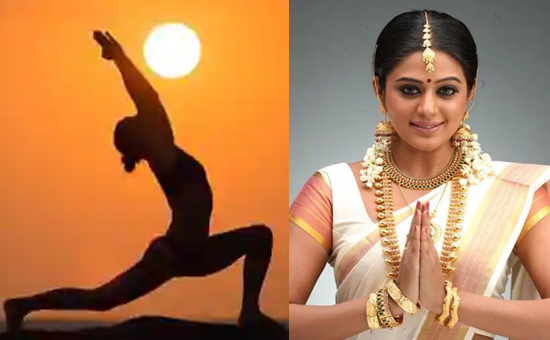Article is about the deeper meaning of Namaste, Pranam Mudra, Pranamasan, types of Namaste to God, Guru & friend,
Cultural education and the to the tenets Yama and Niyam
of Yog sadhana.
With the corona virus pandemic spreading across the world, the
Indian form of greeting - Namaste, has taken a big leap towards international
recognition. Even though it is used commonly by western yoga teachers and
spiritual gurus for some time now, it has taken the virus to literally make
this gesture global.
Since
one way to reduce chance of being infected is by avoiding body contact, constant
warnings are issued to minimise body contact. This is making Namaste become the
popular mode of greeting the world over.
In this tweet Trump gleefully explains how he and the Irish Prime Minister joined hands when they met. He referred to a recent visit to India where he did not shake hands with anyone. According to him India and Japan, where they bow to each other, were “ahead of the curve” from everyone else.
Similarly, a recent video of Prince Charles preferring to join hands
and bowing slightly to others in greeting instead of the usual handshake is
doing the rounds on social media.
Centuries old Indian influence had earlier spread this form of
greeting to Southeast Asia, Indonesia and Thailand. Namaste has now gone
global.
 World leaders greeting with folded hands.
World leaders greeting with folded hands.
A Universal Greeting for Humanity
My Satguru Yogiraj Siddhanath says, while folding hands before every satsang, “I bow to the indwelling spirit residing within you.”
Pujya Gurudev Swami Chinamayanand ji explains why Namaste. “Simple”, he says, “it meant the spark of life in me, and the spark of life in you, these two spiritual essence is one and the same. And to that one Almighty Lord, my Namaskar.”
Sadguru of Isha Foundation says, “If you hold namaskar and look upon someone or something with loving attention, you harmonize.”
This theme recurs in many spiritual Gurus in India who communicate
that with this gesture is revered the Oneness of humanity that transcends all
religion, race, caste and creed. This is the wonder of the philosophy, called
Sanatana Dharma.
In
Sanskrit, Namaste is namaha - salute/bow + te- you; meaning I salute or bow to
you. I have also heard this referred to as nama - salute, haste- with both
hands. Recognised popularly as a greeting, Namaste has embedded in it much more
than a casual hello or good day.
While Indians might be happy to see the Namaste greeting gain
acceptance in the West, many are unaware of the significance of this joined
palm mudra. It has a deeper spiritual meaning as is with everything Indian.
Pranam Mudra
When a person joins the fingers and the palms of both hands they
set into motion various physical, emotional and mental stimulation that forms a
circuit to bring about well being in these bodies.
The hands are one of the Karmendriyas, organ of
action. When joined together they stimulate, through the nerves, certain areas
of the motor cortex in the brain fostering mental
balance and relaxed concentration. Hands are also sensory
organs via the medium of the skin, an Indriya. When we touch anything with our
hands a circuit is formed to relay information to the brain.
In this case, when the hands are joined together, a circuit is
formed between the Ida and the Pingala the sympathetic and
parasympathetic nervous system, bringing a balance between them - the left and
right brain hemispheres by neutralising the two polarities.
Simply put, the right side of the brain regulates conceptual
functions like intuition and creativity while the left regulates analytical
functions and the gesture of joining the hands counterbalances these two
opposite forces.
The aim being to achieve the state of the perfectly balanced ArdhNarishwar, which depicts an unbiased, perfected state of mind.
Pranamasan
This asan, which is the first asan of the Surya Namaskar also does
just this. It brings balance in the practitioner by influencing the left and
right brain. It induces equilibrium in the practitioner and a restful humility
while opening the Anahad chakra to
express compassion.
Namaste to God, Guru and Friend
Since India is a country of ancient wisdom and every gesture is
steeped in inner meaning, where the hand posture of Namaste/Namaskar/Pranam is placed denotes the status of the person in
front.
When one greets the image of the Divine or ones Satguru the joined
hands are placed on top of the head which is the pinnacle of the body temple,
the Sahasrara; when one greets ones
Guru/teacher the hands are placed at the mid point between the eyebrows, the
area of the Agnya Chakra, where knowledge and information is passed through -
the Gurudwar; when one greets friends
it is at the Anahad Chakra the heart
centre of love and compassion.
In the simple gesture of Namaste the thumbs gently press into the
soft spot in the sternum, a reflex point for the vagus nerve. The vagus nerve
as we know carries information between the brain/mind and important organs of
the body. Its stimulation helps restore equilibrium and balance. The folding of the hands invokes love and bowing down of the
head induces respect for the other.
Of course doing the Namaste mindlessly a few times as remedy for prevention of contamination will not induce deeper effects. Only conscious and continuous practice, as taught to children by parents and elders in India, over year’s manifests in a peaceful, harmonious demeanour.
Cultural Education
As I recall from my kinder days, in South India there is no body
contact when two people meet, there is no tradition of hugs and kisses.
Greetings are either joined palm Namaskaram or full prostrations before the
elderly.
Another common method of transfer of this virus, as we know, is
through body fluids especially spit. Spit and spittle were another area of strict restriction in our environment. No food
was allowed to be shared from the same container especially if it touches lips,
finger licking etc. I remember my father refusing money from bank tellers and
tickets from bus conductors if they licked their finger to separate it. We were
not to lick our finger to separate pages of books we were reading. Our
elders understood saliva as an active germ carrier so we were not allowed to spit on the road, in the river or
village ponds.
Finally, a word to the wise at this time of the viral pandemic as
the whole of humanity has been forced to pause and take a collective breath.
As a yoga practitioner and teacher I am forced to consider this a
good time to adhere to the tenets Yama
and Niyam of Yog sadhana, especially Shaucha - personal and environmental
cleanliness, Aparigraha - non
hoarding, avoid stocking up greedily goods and consumer articles, Satya - be truthful about your state and
those of your loved ones regarding exposure, Brahmacharya - live respecting the laws of nature, Swadhyaya - introspect and turn that
lens inwards this forced isolation is a great time for study of the Self and Santosha - an opportune time to
understand how to be happy and content in any given situation.
One cannot but reflect on how humanity has today been brought to a
complete standstill, on its knees so to say. The Earth can take care of itself,
it is we who have to take a moment to reflect on what we are doing.
This virus seems to be that moment for reflection.
Since time immemorial Bharat has been a beacon of light for the
world, our universities of Nalanda and TakshaShila bringing in students from
Greece, China, Iran, and South East Asia to learn spiritual and empirical
sciences.
India and its intellectuals always believed wisdom, knowledge and information must be shared with all equally, they asked for no patents or intellectual property rights.  Yoga is a, selfless, Indian export.
Yoga is a, selfless, Indian export.
Foremost in India’s exports is Yoga, taken to the west over time by many Gurus and imparted in spiritual centres in India to all who come to partake, benefit and share the wisdom. Closely following Yoga is Ayurveda, now a common curative and preventive measure adopted by many all over the globe.
The cultural practices practiced daily without much ado in our
homes, like a dewdrop gently seeps into the psyche of the world without waging
a war.
Now the world is set to adopt India’s traditional form of greeting naturally and simply. The ancient sages were right when they said that Bharat (India) is meant to selflessly share its pearls of wisdom with the rest of the world. Perhaps that is Bharat’s Dharma and how wonderful is that.
Author Jyoti, is a Kriyacharya, has been teaching the practices of the Siddhanath Yoga Parampara since 1999. Her site
Also read
1. The
importance of Shishtachar
2. How Yoga and Ayurvedic Therapy might help prevent being infected by Coronavirus
3. What Mother of Sri Aurobindo Ashram said on being infected by a virus in 1919